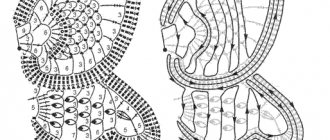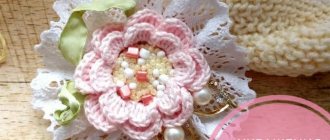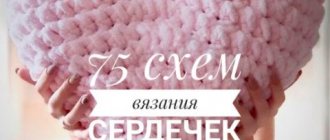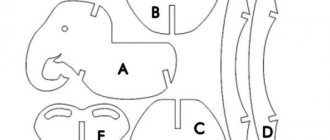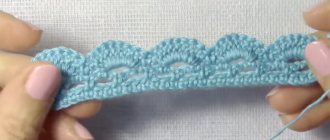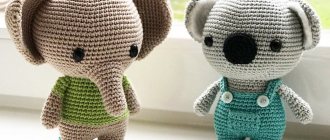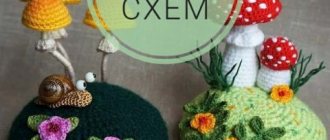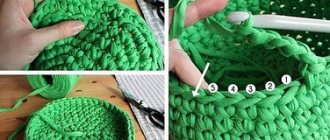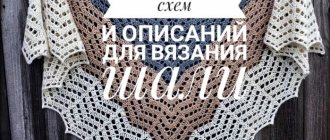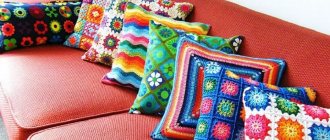The crochet sole is the basis of any knitted shoe - adult or children's.
Can you crochet? Publish your work on kru4ok.ru
Crochet is one of the most common types of needlework. Having mastered this skill, you will certainly not only get tremendous pleasure from the process, but also create products that will warm your soul. You will be surprised, but even shoes are crocheted. The main element of any crocheted slippers is the sole.
Before considering the manufacturing procedure and choosing yarn, you need to find out which shoes can be based on a knitted sole.
- Booties. These are small shoes that are usually worn by babies. A pair made with your own hands can be an excellent gift for the birth of a child. In this category you can show maximum imagination. The brighter the accessory, the happier the baby will be. There are several options for knitting patterns for children's soles.
- Slippers. Suitable for both children and adults. You can make the same type of slippers for the whole family, which will bring you even closer together and bring warmth to your home. For these purposes, use a thick sole.
- House boots with soles. They can be for hot weather or insulated. Fashionable girls will appreciate such a gift.
The sole, as everyone knows, wears out much faster than the rest of the shoe. Therefore, it is important to approach the choice of materials for crocheting responsibly. For adult shoes, it is customary to use a stronger thread, such as hemp rope or knitted yarn. To prevent the knitted sole from wearing out so quickly, wise needlewomen add synthetic thread when crocheting. For children's shoes, soft acrylic is suitable, which will be very pleasant to the touch.
The best materials for the soles of house slippers, methods of fastening
House slippers are a special category of footwear that is invariably in consumer demand. During intensive daily use, even the most durable samples wear out the sole, losing functionality and presentable appearance. As a result, the product may become completely unusable. To avoid this, even at the stage of choosing indoor shoes, it is important to understand which soles for slippers are best and which materials should be avoided. If the base does become damaged, you can restore it yourself, which in most cases is not difficult. To do this, you will need to select the appropriate material from which the new sole will be made, and consider the main methods of attaching it to the upper part. The material collected in the article will help you understand all the intricacies of the process.
Tips for making crochet soles
- If you want a more durable sole, knit it in 2 folds. If the threads are very thin, you can even use 3.
- To keep knitted foot accessories from slipping, add synthetic yarn.
- Thermal adhesive lining material will help provide additional rigidity.
- For children, it is better to make a sole with which it is not difficult to distinguish between the right and left shoes.
- To ensure a tight knitting, select a hook that matches the yarn.
Don't be afraid to create crochet shoes. Our selection of schemes will support you in this interesting matter!
Table of correspondence between sole length and shoe size
Sole for knitted model
When wondering what to make a sole for knitted shoes from, you can take the path of least resistance. The simplest solution is to take a ready-made factory-made thermoplastic blank and sew it onto the slippers yourself. If a more economical option is preferred, you can make the base yourself from scrap materials. For example, take the bottom of an old shoe, use an awl to punch holes around the perimeter and tie (sew) it to the new products.
You can also make soles for knitted slippers with your own hands, armed with knitting needles or a crochet hook. The procedure is as follows:
- Draw the foot on a piece of paper, this will be a kind of pattern. You can use it to make a template, for example, from foam rubber. Add allowances of 0.5-1 cm along the entire perimeter, especially if the slippers are knitted for a child.
- Cast on the required number of air loops, the length corresponding to the previously prepared template. During the knitting process, add loops on each side of the product in places where the pattern widens, or decrease in places where it narrows.
- Use sc in the first row and with 1 dc in subsequent rows. To achieve a rounded shape of the front and back parts, you need to knit 2 stitches several times in 1 loop. If an insole is provided, the bottom and top layers are joined without a crochet.
During the knitting process, the outer loops are not tightened too much, which will facilitate subsequent connection to the upper part of the slippers.
The material for a knitted sole can be wool yarn, cut leather strips, durable household cord, fabric scraps (prepared for work in the form of ribbons) - it all depends solely on the imagination of the craftswoman.
Technology of taking measurements for knitted shoes
To make your own home shoes that fit exactly, you need to measure your foot. To do this, take an elastic measuring tape, a notepad and a pen. Measure the length and width of the sole, the height of the instep, and, if necessary, the girth of the base of the shin. Then convert the centimeters into loops and rows:
- Link the sample.
- Count the number of loops in it and divide by the width.
- Then the number of rows is divided by length.
- Multiply the resulting values by your parameters.
- And draw a schematic pattern.
How to replace it yourself
If the sole of your favorite slippers is worn out, you can simply replace it with a new factory analogue. As an option, cut off the base of sneakers prepared for disposal. Or make a sole with your own hands, using a little imagination. The room for maneuver is quite wide: leather, suede, leatherette, carpet, microporous rubber, felt. Unexpected solutions for the soles of slippers: heat-resistant napkins folded in several layers, orthopedic insoles.
To sew a new base to the slippers, you will need:
- soles cut according to a template from existing material;
- glue (you should choose the right one based on the raw materials);
- tailor's needle and strong thread;
- sandpaper;
- acetone.
The first step is to remove the old sole from the slippers - to soften the dried glue, the junction of the upper and lower parts is impregnated with acetone. Next, the algorithm of actions will be as follows:
- The areas to be joined are thoroughly sanded with sandpaper, paying special attention to the edges of the slipper material.
- Degrease the cleaned areas with acetone and leave for some time to dry completely.
- Coat both parts with suitable glue and let it dry for a couple of minutes.
- Another layer of glue is applied to both surfaces to be glued, then they are pressed tightly against each other.
- To ensure secure fastening, the sole is stitched in a circle in one row with a distance from the edge of approximately 0.5 cm.
The last step is relevant for materials with a plastic structure that will not be damaged by piercing - for example, felt, leather or rubber. All other types of soles should be clamped with yews, placing them between two fiberboard plates of a suitable size. You should hold it until the glue has completely dried, and after the required time has passed, you will need to carefully remove its remnants with fine sandpaper.
Video - tutorials on crocheting soles
Crochet sole made of knitted yarn
Yarn LOVE IS from the manufacturer DomPryazhi.
The basis of any knitted slippers is a reliable, dense double sole. You can link one with us. The master class is suitable for both beginners and experienced masters. Join us to watch this video tutorial!
Galina Kushnir is a virtuoso with many years of experience. She always shares the secrets of knitting from different types of yarn. Yarn LOVE IS is
- Thread length: 95-110 m.
- Thread width: 7-9 mm.
- Tool: 10 mm hook
- Weight: 320-340 gr.
The video should load here, please wait or refresh the page.
MK sole for slippers crocheted 18 cm long
For my daughter’s foot, which is now 18 cm, I developed my own pattern for crocheting a sole from existing ones. The MK has a hand-drawn diagram for both legs. I tried to make it possible to at least slightly distinguish the left slipper from the right one. I used a 6-point hook and threads that matched the thickness of the hook (I won’t say the composition of the threads, I used my mother’s nameless bins).
The video should load here, please wait or refresh the page.
DIY slipper soles in a couple of hours
I want to make slippers with dense and thick soles. I tried to make a sole from 8mm thick travel foam. I even folded it in two layers, but it quickly pressed down to a thickness of 1-2mm. Yes, and it bends very easily.
I would like to do something like this:
to photo hosting →
Does anyone know what this material for the sole might be called? And what else can a sole be made from?
Thank you in advance
| desvil Oh, I also found some pictures, but all the descriptions are in hieroglyphs. The material is very similar to the foam from which rugs and seats for hiking are made. Does anyone know what it's called? |
Warm boots
To make the shoes shown in the photo for yourself or your loved ones, you need to prepare a piece of felt, several old T-shirts, a hook and hosiery knitting needles. Then cut out the parts marked in the photo from the material. They must first be adjusted to the required dimensions. After this, you should sew the parts. Cut unwanted clothing into long strips about the width of a finger. Roll it into a ball. Cast on a loop along the top edge using the prepared “yarn” and distributing it onto the knitting needles. Raise the boot to the desired height and then close the loops.
Soles for slippers.
A frequently asked question is what to make the soles of felted slippers from. I have FOUR options: 1. Latex - natural rubber. Apply with a brush to the soles in at least three layers. I use it most often on children's slippers. The sole does not slip. Many people criticize it because of its fragility, like...
BoosaI sewed myself slippers with felt soles. They wear quite well and are warm in winter. And where linoleum is laid, they work great. I sewed slippers for my husband, took gacha from old boots for the soles, lined them with synthetic padding to make it warmer, and modeled them like an instep support. They are more convenient. Linka-kalinka
I want to make slippers with dense and thick soles. I tried to make a sole from 8mm thick travel foam. I even folded it in two layers, but it quickly pressed down to a thickness of 1-2mm. Yes, and it bends very easily.
I would like to do something like this:
to photo hosting →
Does anyone know what this material for the sole might be called? And what else can a sole be made from?
Thank you in advance
I also thought about this option for the sole, but my machine will not take such a thickness, and I need to glue it with shoe glue (Moment glue is not at all for shoes - the sole falls off after 2-3 days) I had to settle on another option, patterns and description here – https://club.osinka.ru/topic-76353?p=11186476&highlight=#11186476
Children's boots
Kids love various indoor shoes decorated with funny animal faces. At this point, we invite readers to make an option similar to the one shown in the photo. To perform it, you need to prepare the material and cut out the main parts from it. It is important to note the following: to make the product look like a store-bought item, it is also recommended to cut out the inside of the shoe - the lining. Next, cut out the ears, muzzle and tail from the material of the desired color. Then sew the parts together and decorate the boots with additional details.
Soles for slippers
Girls, can you share your experience in making soles for slippers or felt boots? Perhaps there are stores that sell ready-made soles, or materials, such as rubber?
what a great question! I'm also very interested!
I use genuine leather for the soles of slippers and hem them with the suede side up.
And for felt boots you can make a sole in a shoe workshop. And don’t waste time searching, and they will deliver it professionally.
You know, I already looked at a shoe workshop, but they cut out the sole from a layer of rubber, but I would like a corrugated one. like on sports shoes, for example.
Thick leather or suede are perfect for slippers. Such a sole is not very suitable for street shoes, but you can either cut the sole out of rubber yourself and sew it on with a special tool, or you can actually take it to a workshop
For slippers I also use genuine leather or suede: they don’t slip, look good and last a long time.
I give my felt boots to the workshop, they make them very quickly and efficiently!
I also make the soles of the slippers from leather, with suede on top.
I also sometimes use silicone (construction grade), I just coat the entire sole with a thin layer, it takes about 3-4 hours to dry, but it’s transparent, doesn’t slip and doesn’t rub off!
Good idea about silicone! Thank you.
For children's slippers and booties, for children who are already stomping, I use sanitary silicone for the bath and kitchen, it’s perfect! I apply a thin layer, at first the smell is disgusting, but it disappears in an hour and I let them dry for about a day, just to be safe!
Tell me, please, where do you buy leather? Or are these ready-made leather insoles?
I buy whole skins at the base. Search the Internet, there are sites that sell leather of different thicknesses. For me, the most adequate leather was 0.8-1 mm, but you need to punch holes separately. or you can take a thick piece of clothing
What to punch with? And what is the minimum thickness allowed?
I punch with a nail and a hammer :-)) Well, sometimes with the help of my husband. The minimal one I took was clothing leather, it is soft and quite thin. I put it on children's slippers
I sew a leather sole on a machine with a thick needle at the maximum stitch length without thread, and holes remain, it’s easy to sew on them by hand
Thank you, Lyudmila! On a leather machine?
No, on the regular one! I put a needle on the skin
Everything ingenious is simple!! Thanks for the idea, I’m struggling with punches and measuring. )))Thanks again!
Dear masters, I have two questions:
1) how does a leather sole behave after washing (during wear), I mean indoor shoes and shoes for children, does the leather crack or harden, does it shrink, and does it need to be greased after washing to soften it;
2) should felt boots have a wide flat sole so that the sole can be glued to them in the workshop? Are there any requirements from the workshop?
And also, maybe this is a question on another topic, but has anyone tried making shoes with instep supports and what is the correct way to lay out the wool for such a sole?
Soles (sports) are now on sale in DICATHLON stores, take a look. I really liked it, I made summer moccasins based on them.
Natalia, thanks for the advice, I’ll have to see what kind of miracle this is :) and how much does it cost??
I sometimes hem it with leather, which I buy whole skin. I take “cuts”, they are not expensive, or I buy trimmings by weight, but if you can choose the right size. I make holes with a punch. It is very comfortable. The punch allows you to set different hole diameters. It can also be used to punch holes in a belt. The punch can be purchased at a specialized store. Currently I use wear-resistant prophylaxis more often. It is sold in specialized shoe stores. Optimal thickness up to 2.5 mm. Of course, it can be thicker, but then it will need to be glued. I washed it with preventative care, no problems at all. Leather tolerates washing less well, and in general its service life is shorter compared to prevention
